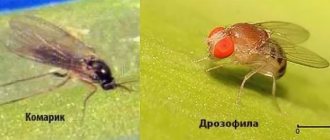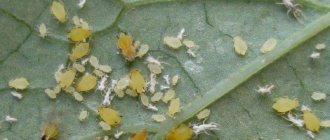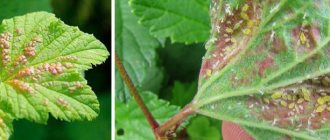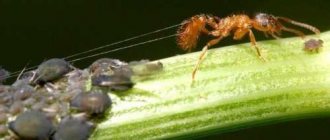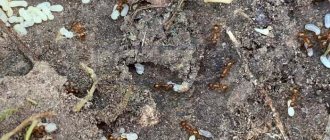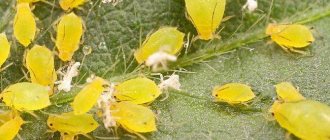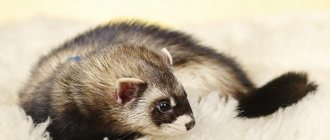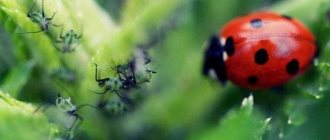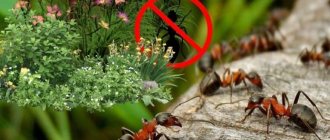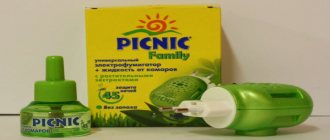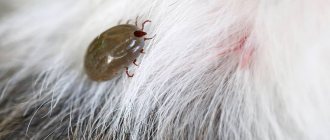Tobacco thrips is not only a major pest of tobacco - it also damages vegetable crops such as onions, cucumbers or potatoes. In addition, it transmits viral diseases, which makes this insect a very dangerous pest for crops.
Unfortunately, tobacco thrips are not the only type of thrips that are not averse to feasting on our harvest. For example, wheat thrips can cause great damage to cereal crops.
Who is tobacco thrips?
Tobacco thrips is a tiny insect that is a pest of tobacco, lily, pumpkin, melon and vegetable crops.
Thrips damages approximately 400 plant species and is distributed throughout almost the entire territory of Russia.
Description of the larva
The tobacco thrips larva resembles the adult, but without wings. Its color changes depending on the stage of maturation from white to yellow.
Description of the adult
An adult thrips has a narrow, oval body that is approximately 0.8–0.9 mm long. It has two pairs of narrow gray-yellow wings surrounded by fringe. Females and males have some differences.
The female can be either light yellow or dark, almost black, brown. It has a transverse head with small setae and a transverse prothorax. The forewings are slightly yellowish, and the lower legs and thighs are grey. The male is smaller than the female, approximately 0.1–0.3 mm. The antennae are darker, and the body, on the contrary, is lighter.
The tobacco thrips differs from other species of thrips in that it has four distal setae on the fore wings and an almost transparent first antennal segment.
Subspecies of tobacco thrips differ in body color. Dark ones are usually found in spring, and light ones in summer.
Plants that secrete phytoncides to attract entomophages
There are plants that, when grown in your own area, help create an environment favorable for beneficial insects.
It should be noted that many of these herbs not only attract entomophagous insects, but also repel certain pests. Thus, having these plants on your site, you can, as they say, kill two birds with one stone and completely abandon the use of pesticides and pesticides.
Some garden crops are also capable of attracting beneficial insects, for example, legumes (vetch, clover). The latter not only, as noted earlier, enrich the soil with nitrogen, but also provide entomophages with moisture and food.
In order for herbs that attract entomophages to bloom in the area throughout the season, first of all you need to plant those plants that bloom earlier. For example, you can first plant buckwheat and then dill in one bed. It is better to sow marigolds and calendula as early as possible so that they bloom in mid-summer. Another option is to simply plant herbs in one place that bloom for a long time (clover, tansy, navel).
Plants that protect against pests, which serve to attract entomophages and provide the opportunity to maintain a natural balance between the number of unwanted and beneficial insects, include the following.
Lemon marigolds.
This plant attracts spiders and small wasps. It is best to grow marigolds using seedlings. Marigold seedlings are planted in the ground after frost has passed.
Buckwheat.
This is a honey plant that attracts ladybugs, bees, hoverflies, predatory bugs, and flies to the site. Buckwheat is an effective soil-forming plant that increases the content of organic matter in the soil.
Sweet clover officinalis.
It is a biennial plant, a good honey plant, and has small yellow flowers. The aroma of sweet clover attracts many beneficial insects, including pollinators. In addition, sweet clover is a soil improver.
Spearmint.
Spearmint attracts spiders and flies. It is a herbaceous perennial plant with lance-shaped bright green leaves, creeping roots and pink or purple cone-shaped flowers.
Common tansy.
It is capable of attracting predatory bugs, ladybugs, lacewings, parasitic wasps, as well as flies to the site, since this plant is an excellent source of their nutrition. Tansy is known to repel pests such as the Colorado potato beetle.
Dying navel.
This plant is perennial and attractive to flies and wasps. During flowering, it is covered with small yellow flowers, shaped like calendula flowers. A distinctive feature of the plant is the characteristic aroma emanating from it.
Reproduction method
For the winter, females go into the soil or plant debris to a depth of 5–7 cm and emerge in mid- or late April, colonizing weeds. They lay eggs in the leaf tissue, about 100 eggs per
life. Fertility depends on the type of food plant and temperature. The most intensive development occurs in arid places.
Tobacco thrips is almost never found on young or aging leaves. Most of them are located on the formed ones. The larvae are found on the lower part of the leaf, less often on flowers or fruits.
The embryo develops from three days to a week, then passes through the larval stage for about 10 days. They go into the soil. And after about another week, adult insects rise to the surface.
Females and their offspring fly from weeds to crops and cause damage.
Prevention
If you do not buy soil for planting flowers in a store, but dig it yourself, for example, from the same garden, it must be disinfected; to do this, treat it with such agents as “Antonem-F” or “Nemabakt”. Do not forget that plants need to be watered periodically so that the soil does not stand dry, and also carry out loosening.
Purchased flowers or those brought from the garden can also be carriers of these pests, so place them away from indoor plants.
To repel parasites from plants both in the garden and in the apartment, you can use strong-smelling flowers. For home flowers, you can prepare an infusion from plants such as celandine, marigold, and tobacco. And in the area in the garden where you notice the appearance of these insects, simply plant the same plants; they will help not only in the fight against thrips, but also with many other pests, for example, ants.
What harm does it cause to plants?
Tobacco thrips harms onions, cucumbers, zucchini, eggplant, melons, and sometimes cabbage, celery and parsley. Damage is caused by both larvae and adults.
Tobacco thrips sucks the juice from the leaves, which leads to moisture deficiency and the formation of yellow-brown spots. Petals and stamens are also damaged. When there is a high density of insects, the leaves curl, turn yellow and dry out completely. In addition, thrips can feed on the sap of flowers, causing them to fall off prematurely.
The striped click beetle larva is the most “voracious” stage of the insect’s life cycle. To get rid of the Swedish fly, you can use various control methods - both chemical and folk. You will find detailed information in this article.
Pea weevil larvae are about 6 mm in size. Read the full description of the insect at the link.
Precautionary measures
Despite the fact that tobacco infusion against pests is non-toxic, you should adhere to some safety measures
Since careless use can cause health problems, you must:
- wear a cotton-gauze bandage to protect the respiratory tract;
- rubber gloves are used to protect the skin of the hands;
- eye protection glasses;
- If the drug gets on the skin and mucous membranes of the eyes or mouth, rinse thoroughly under running water.
- while carrying out work to get rid of pests, you must not smoke, drink or eat food;
- at the end of the procedure, wash your hands and face well with soap;
- Children, pregnant and lactating women, as well as people with allergies are not allowed to work with the infusion;
- preparations of dried raw materials for the drug must be done with gloves and scissors;
- store the prepared raw materials with signed labels, because not only fresh tobacco is used to make the infusion, but also dried tobacco;
- The dishes used for making the infusion must be washed with a solution of soda ash or wood ash, and then rinsed with plain water.
Thanks to tobacco infusion, you can get rid of almost any harmful insect for home crops
It is important that this method is not only effective, but also economical
How to deal with the pest?
Consider the following pest control measures:
- agrotechnical,
- biological,
- chemical.
Agrotechnical methods
- ensuring high air humidity and uniform watering, since tobacco thrips mainly develops on those crops that grow in dry places;
- digging up the soil and eliminating post-harvest residues;
- weed control, as thrips reproduce and feed on them in the spring;
- placing onions as far as possible from other crops to prevent them from being colonized by tobacco thrips, since it is onions that are most often damaged by this pest.
Biological methods
- Predatory phytoseiid mites (Neoseyulus) effectively fight thrips larvae. The application rate is 300–500 females per plant. They are bred on wheat bran and fed with cancer mites;
- orius bugs and anthocoris bugs.
Chemicals
Insecticides are applied at weekly intervals. Cannot be used on onions grown for greens. The following remedies are effective:
- "Aktara", VDG (400 g/ha);
- "Karate Zeon", MKS (150–200 ml/ha);
- “Fufanon” (1 ampoule per 1 liter of water);
- "Commander Maxi" (3 g/ha);
- "Iskra Zolotaya" (10 ml/ha).
You can also use an infusion of onion peels - 4 liters of water per 2 liters of peels, after two days add another 12 liters of water and add laundry soap. Before storing the bulbs, they should be treated with sulfur gas (50 g of sulfur is used per 1 m3 of room).
The use of these methods (separately or in combination) will help rid tobacco and vegetable crops of tobacco thrips, and the use of uninfected planting materials will reduce the risk of its occurrence in the future.
Remedies for thrips (preparations)
Chemical agents are the most effective in combating thrips. The insecticidal preparations that are used to combat this pest will be described below:
- Agravertine. This enteric-contact biological agent is used to exterminate sucking insects and is highly effective. Preparation of the solution: 10 milligrams per 1 liter of water.
- Aktara. This enteric-contact drug is highly effective and is very quickly absorbed by plants.
- Actellik. An organophosphate preparation with a wide spectrum of contact-intestinal action, it is used in the fight against mites, sucking and leaf-eating pests. Solution: one ampoule for 1 liter of water.
- Vertimek. This is an insectoacaricidal agent, characterized by an enteric contact action, which is used to protect crops in a greenhouse, as well as indoor flowers. Solution: 2.5 milligrams per bucket of water.
- Decis. A broad-spectrum contact preparation that is effective in the fight against sucking and leaf-eating pests, and it destroys both larvae and adults.
- Imidacloprid. This drug is capable of exterminating various pests. It is used as an active ingredient in the manufacture of various modern drugs.
- Inta-vir. The product is used to destroy various pests on garden and garden crops, both in open ground and in greenhouses. It is not dangerous for humans and pets. Solution: one tablet per 2 liters of water.
- The spark is golden. This highly effective drug is used in pest control.
- Karate. This highly effective contact agent perfectly exterminates pests. Solution: 2 milligrams per bucket of water.
- Karbofos. A moderately toxic pesticide used to control pests of vegetable and fruit crops, grapes and citrus fruits. Solution: 7.5 milligrams per 1 liter of water.
- Mospilan. This systemic product acts very quickly and is capable of exterminating pests at any stage of development.
- Spintor. This biological agent has a unique mechanism of action against many pests.
- Fitoverm. This biological product, made on the basis of the vital activity of soil microorganisms, is used to protect indoor flowers from harmful insects. Solution: 1 milligram of product per 100 milligrams of water.
- Fufanon. A broad-spectrum organophosphorus drug has intestinal, contact and fumigate effects.
Onion fly
If your onion plantings begin to gradually fade, its leaves turn yellow, and the bulbs are completely rotten, you should take a closer look - most likely, an onion fly has settled somewhere nearby.
The onion fly is the biggest fan of the burning vegetable, and therefore you need to fight it seriously and decisively. But it’s not so easy to notice this pest: this small (6-8 mm) yellow-gray or ash-gray insect is very similar to the most common house fly. But even this pest can be fought, and quite successfully.
Measures to combat onion fly
You will always have time to fill your garden with chemical poison. Start with less drastic measures:
- for prevention purposes, before the onion fly attacks, spray the beds with infusions of mint, valerian, pine needles, fir, tomatoes or wild rosemary (the pest cannot stand the smell of these plants);
- alternate planting onions and carrots (the onion fly does not tolerate the carrot aroma);
- sprinkle the beds with onions with ash (ash will not only repel the pest, but will also serve as an excellent fertilizer for the soil);
- water the beds with a solution of table salt;
- observe crop rotation (take a break from planting onions for 3-4 years);
- Soak onion sets in a solution of potassium permanganate before planting;
- in the fall, dig the soil deeply (to a depth of at least 25 cm);
- every 4 days, loosen the soil around the bulbs (the onion fly does not like to lay eggs in loose soil);
- Mulch the onion plantings with peat or dry, semi-rotted manure.
The first time the beds are treated with a solution of table salt, when the onion sprouts reach a height of 5 cm (300 g of salt per bucket of water). The second treatment is carried out after another 2-3 weeks (450 g per 10 liters of water). The third - after another 3 weeks (600 g per 10 l).
If the onion fly did not understand your transparent hints in the form of non-chemical measures, it’s time to move on to the “heavy artillery”. A number of chemicals can help you in this battle for the harvest: Aktara, Karate Zeon, Fly Eater and many others.
Onion hoverfly
Bronze-green, with light gray stripes on its back, the onion hoverfly literally steps on the heels of its predecessor, the onion fly, trying to snatch primacy among onion pests from its thin legs. This small insect (up to 9 mm) spoils not only onion plantings in the beds, but also forced onions standing on your window
An extremely harmful individual, isn't it? Therefore, it is important to notice it in time: the first sign is yellowing onion leaves. The sad outcome is rotting of the bulbs
The onion hoverfly's flight begins with the beginning of rosehip flowering.
Measures to combat onion hoverfly
Experienced gardeners carry out a number of activities that help eliminate the onion hoverfly. They know for sure that it is not at all necessary to immediately grab onto “chemistry” - first you need to use “folk” means of struggle.
- carry out autumn digging, thereby destroying the pest larvae;
- pre-soak the planting material in a solution of potassium permanganate (this will destroy the pest larvae that may be in the seedlings);
- plant carrots next to the onions (it will repel not only the onion fly, but also the onion hoverfly);
- observe crop rotation, maintaining a break of 3-4 years before returning the onions to their original place;
- Early planting of onions can also provide protection against pest attacks;
- to repel the onion hoverfly, pollinate the plantings every week with lime, mothballs, ash, tobacco dust or ground pepper;
- mulch the beds with chopped spruce branches, rotted manure and peat.
To speed up the growth of onions and reduce the likelihood of damage to the plantings by the onion hoverfly, use 3 liters of urea solution per 1 sq.m of bed (1 tbsp urea per 10 liters of water).
Preventive measures
Simple steps that need to be performed regularly will help you avoid infection. These measures are universal (suitable for garden, garden, and home plants):
- daily thorough inspection of all parts;
- timely removal of dust, organic residues, fallen leaves and flowers;
- control the level of humidity (avoid drying out, especially in winter).
Thrips are a small pest that poses a threat to any plants. Indoor flowers, seasonal crops, garden trees - the parasite settles on any of them. Thrips feed on cell sap and carry dangerous diseases. In the absence of timely assistance, the infected plant dies. With “massive” populations of thrips, the entire crop or the entire collection of indoor flowers is at risk.
Pest on indoor plants
Fans of indoor floriculture should be prepared that their plants may suffer from various genera of thrips. As a rule, these are the following types of pests:
- bulbous;
- tobacco;
- floral;
- decorative;
- heterovorous.
If the plants show signs of infection, it is advisable to wash them in the shower. After this, move all pots with suspicious flowers to a separate room. If possible, you need to transplant the plants into new soil or replace its top layer. If the damage is minor, all parts of indoor flowers can be treated with any folk remedy, for example, garlic infusion. If buds or flowers appear on diseased indoor plants, they need to be removed, as thrips love to feed on them.
